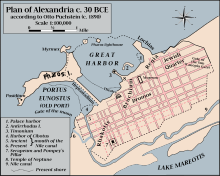Palladas
Palladas (
Life
All that is known about Palladas has been deduced from his 151 epigrams preserved in the Greek Anthology (Anthologia graeca); another twenty-three appear in that collection under his name, but his authorship is suspect. His poems describe the persona of a pagan schoolteacher resigned to life in a Christian city, and bitter about his quarrelsome wife.
Works
One of the epigrams attributed to him on the authority of

An anonymous epigram (Anth. Gr. 9.380) speaks of Palladas as having a high poetical reputation. However, Isaac Casaubon dismisses him in two contemptuous words as versificator insulsissimus ("a most coarse poet"). John William Mackail
There is little direct allusion in his epigrams to the struggle against the onslaught of Christianity. One epigram speaks obscurely of the destruction of the "idols" of Alexandria popular in the
A Question of Gender
Γραμματικοῦ θυγάτηρ ἔτεκεν φιλότητι μιγεῖσα |
The dominie's daughter eloped with a suitor, |
| —Translated by Sir William Marris |
This translation omits the epigram's explicit reference to the role of grammar and thus grammatical gender in thought. Compare: "A grammarian’s daughter made love and then bore/A masculine and feminine and neuter child."[5]
The epigram's reference to the generative role of grammar underscores how the epigram is "likely quite dark: [the daughter] gave birth to twins (a boy and a girl) and at least one of them died thus giving the three declensions."[6]
Date
Mackail groups Palladas to the same period with
as epigrams.Notes
- Journal of Roman Studies, 99 (2009), pp. 36–60.
- ISBN 978-0-9799758-5-1 See the review by Lucia Floridi, CJ-Online 2014.04.07.
- ^ Cf. reviews by R. Ast, in BMCR 2014.02.23, and J. Dijkstra, in Phoenix, 68 (2014), 370–373, with Wilkinson's response in "More Evidence for the Date of Palladas" Zeitschrift für Papyrologie und Epigraphik, 196 (2015), 67–71, and "ΠΡΥΤΑΝΙΣ and Cognates in Documentary Papyri and Greek Literature" Zeitschrift für Papyrologie und Epigraphik, 196 (2015), 88–93; see, most recently, A. Cameron, "The Date of Palladas" Zeitschrift für Papyrologie und Epigraphik, 198 (2016), 49–52.
- ^ Bowra, C. M.; Higham, T. F., eds. (1938). The Oxford Book of Greek Verse in Translation. Oxford: Clarendon Press. p. 655.
- ^ Harold Anthony Lloyd, The Complete Palladas.
- ^ Harold Anthony Lloyd, The Complete Palladas.
References
- K. W. Wilkinson, "Palladas and the Age of Constantine", The Journal of Roman Studies, 99 (2009), 36–60.
- John William Mackail, Select epigrams from the Greek Anthology
- Harold Anthony Lloyd, The Complete Palladas (complete verse translation of all the epigrams)
- "Palladas", William Smith, ed., Dictionary of Greek and Roman Biography and Mythology, vol. 3, p. 94.
External links
 Greek Wikisource has original text related to this article: Παλλαδᾶς
Greek Wikisource has original text related to this article: Παλλαδᾶς
